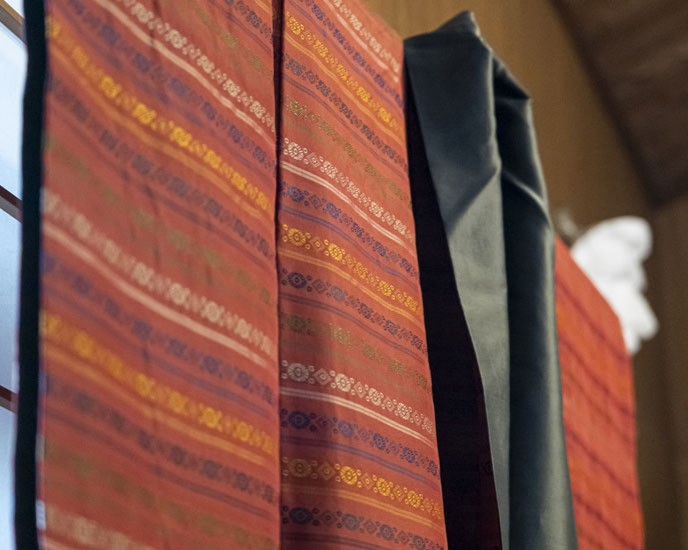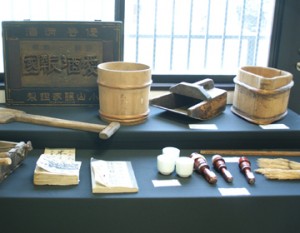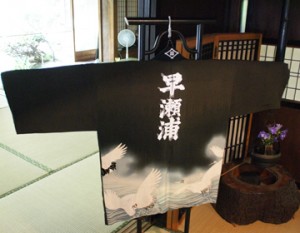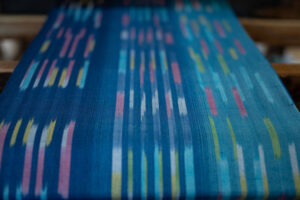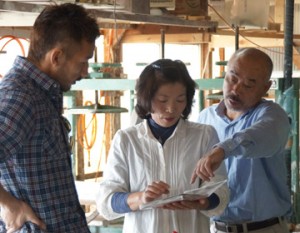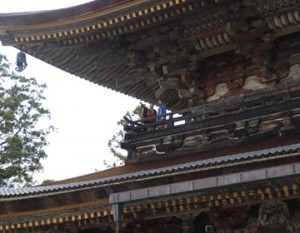During the time of the Ryukyu Kingdom, Okinawa produced beautiful crafts in such genres as lacquer, ceramics, goldsmithing, and dyeing and weaving. Among these, textile dyeing has taken root throughout Okinawa, reflecting the history and culture of the region. Fascinated by “Shuri textiles,” Kyoko Shukumine, a living national treasure, has been preserving and passing on the techniques to the future.
Shukumine Dyeing and Textile Research Institute, which preserves the dyeing and weaving culture of the Ryukyu Islands.

The Shukumine Textile Research Institute is located in Naha City, Okinawa Prefecture, and is headed by Kyoko Shukumine. The institute aims for the revival and development of traditional crafts and supports Okinawa’s rich textile culture. At the institute, Ms. Shukumine creates new works while preserving the textile traditions of Shuri.
The charm of Shuri textiles is their timeless beauty

Okinawa has been designated by the government as one of 16 traditional crafts, 13 of which are dyed fabrics. It can be said that Okinawa is one of the leading dyeing and weaving production centers in the country. In particular, textiles made in Shuri are characterized by a variety of colors and intricate designs using a dyeing and weaving technique that has been used since the days of the Ryukyu Kingdom. It is known as the fabric of choice for people who enjoy wearing kimono.

However, due to the warfare of World War II, Shuri’s weaving techniques were almost completely lost. Mr. Shukumine has been working to restore the weaving techniques of Shuri and bring back its brilliance to the present day.
The Art of Seven Techniques

There are seven major weaving techniques used in Shuri, including “Shuri Hanakuraori,” “Shuri Hanaori,” “Shuri Dotonori,” “Tejimari,” “Shuri Kasuri,” and “Shuri Minsa.
Among them, “Shuri Hanakuraori” is the most prestigious of all Okinawan textiles, made by alternately weaving hanaori and roori in a checkerboard pattern. It is said that this textile was worn by kings and queens as summer clothes during the Ryukyu Kingdom period.
Attractiveness created by color and design

The greatest appeal of Shuri textiles lies in their rich colors and design. Okinawans are skilled in design,” says Shukumine, who creates pieces that incorporate modern sensibilities while preserving traditional techniques. The fusion of tradition and innovation brings out new charm in Shuri textiles.
Kyoko Shukumine’s Steps, Encounters with Textiles and Passion for Textiles

Mr. Shukumine was born in Naha. Her mother, a war widow, raised eight children by herself. She says, “Watching my mother’s back, I realized that even women need to learn handicrafts. So I went to Joshibi University of Art and Design in Tokyo to study design. I wanted to study design that was more in tune with modern life,” she said. And then she met someone who would become a turning point in her life.
To the path of dyeing and weaving. Encounter with Yoshitaka Yanagi spins a new path.
Ms. Shukumine’s path to dyeing and weaving began with an encounter with Yoshitaka Yanagi, a nephew of Muneyoshi Yanagi, a well-known folk art activist who pursued beauty in everyday items made by hand. He said, “I wanted to study design in Tokyo, so I went to Joshibi University of Art and Design. There, I learned a lot from Mr. Yanagi, who had a deep knowledge of Okinawan dyeing and weaving. Until then, I still did not know the beauty of Okinawan textiles. says Mr. Yanagi. Under the guidance of Etsuko Yanagi, he was awakened to the charm of textiles from his birthplace of Shuri and entered the world of textiles. Most of Okinawa’s textiles were lost in the war, and there was an overwhelming shortage of sample textiles, but Shukumine devoted himself passionately to the restoration of Shuri textiles.
From a Technology Learner to a Teacher

Just as he was considering whether to engage in weaving as a career after graduating from college, he received an offer from a local high school in Shuri to teach textile dyeing and weaving. Mr. Shukumine, who was not comfortable speaking in front of others, resisted the idea of teaching at the school. Although he thought it was not for him, he decided to accept it as his “mission” because there were many things he wanted to do, such as restoring Okinawan textiles that had been lost after the war.

While teaching, he continued to create, and in 1977 received the Prime Minister’s Award at the first “Exhibition of Traditional Crafts,” which later became the most prestigious exhibition of traditional crafts in Japan. The work he produced at that time used a classic Shuri kasuri technique called tejima.
The Prime Minister’s Prize that I received at that time inspired me to take a fresh look at the classics.” From this point on, he became more deeply involved in traditional Shuri textiles.
In Search of Lost Okinawan Textiles. A Journey to Germany

In order to restore Okinawan textiles lost in the war, Shukumine searches for fabrics to use as samples. However, no matter where he went, he could not find any. As he continued his research, he learned that dyed textiles from the Ryukyu Kingdom period were in the collection of a museum in Berlin. He traveled to Germany in 1992 as an overseas researcher for the Ministry of Education. He collected dyed and woven textiles from the Ryukyu Kingdom period scattered throughout Germany while conducting research, compiled textile techniques and brought them back to Okinawa, and upon his return to Japan, reproduced several Shuri textiles from the dyed and woven textiles of the Ryukyu Kingdom period. Later, in order to further deepen his research on textiles, he went to Germany again in 2012 to collect more detailed data and photos, and Shukumine summarized his field research and wrote a report summarizing the techniques so that anyone can weave.
Prospects for the future, Kyoko Shukumine’s vision of Okinawa’s dyeing and weaving culture

After retiring from his position as a professor at Okinawa Prefectural University of Arts, Mr. Shukumine established the Shukumine Dyeing and Weaving Institute in Naha City in 2003. Along with research, education, and lectures on Okinawan dyeing and weaving, he has continued to create new works that fuse traditional dyeing and weaving techniques with originality. In recognition of his achievements, he received the 24th Pola Prize for Traditional Culture in 2004 and was designated a living national treasure in 2023 as the holder of the “Shuri textile” technique. I think this is fate,” says Shukumine.
Fascinated by the world of colorful weaving colors expressed by warp and weft yarns, Ms. Shukumine continues to create new works that weave together tradition and innovation in order to pass the baton of “the charm of Shuri textiles” from the past to the future. There is no doubt that her passion will bring new life to the dyeing and weaving culture of Okinawa.



